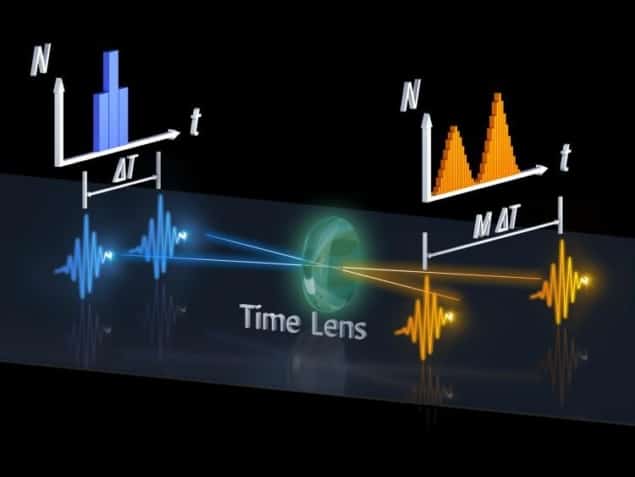
A new “time lens” that can magnify the difference in arrival times between individual photons within an ultra-short pulse has been developed by researchers in the US. Using an advanced optical setup, Shu-Wei Huang and colleagues at the University of Colorado, Boulder, showed how the arrival times of individual photons within a femtosecond-length pulse could be stretched out while retaining the quantum information that they carry.
Time-correlated single-photon counting (TCSPC) is a long-established technique for obtaining precise 3D images of objects ranging from molecules to geological features. It involves measuring the times taken for individual photons from a pulsed laser to bounce from an object and travel to a detector.
Through additions including photomultiplier tubes and superconducting nanowires, physicists have greatly improved the resolution of this technique in recent years and it can now distinguish between photons separated by times as small as 3 ps. This has proven particularly useful in studying molecules, whereby the laser pulses cause the molecules to emit photons of fluorescent light.
To further improve this resolution, Huang’s team have developed a new time lens, which instead of magnifying physical space, magnifies the time separating the arrival of individual photons.
Late arrivals
The team’s optical setup comprises an off-the-shelf single photon detector, a 30 m spool of nonlinear optical fibre and two pulsed lasers. When a pulse passes through the time lens, Huang and colleagues found that photons at the leading edge of the pulse speeded up, while the photons at the trailing edge slowed down. As a result, the researchers could clearly distinguish between photons arriving earlier and later within the pulse, while retaining the quantum information contained within each photon.

New way of seeing round corners has picosecond temporal resolution
Overall, the setup magnified photon separation times by a factor of 130, to within an accuracy of about 20 fs, and with a 97% photon conversion efficiency. This allowed the team to resolve ultrashort pulses just 130 fs in duration: several orders of magnitude shorter than those resolvable with existing technology.
Although the widespread use of the time lens in TCSPC is still some way off, Huang’s team hope that their new “quantum stopwatch” will pave the way for new advances in lab-based imaging in the future. If achieved, the technology could aid studies of a wide range of ultrafast, molecular scale processes including chemical reactions and metabolic processes taking place within cells.
The research is described in Optica.



